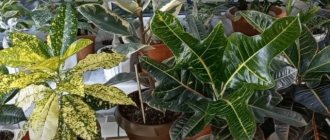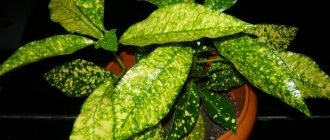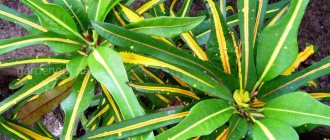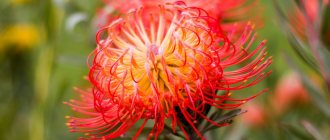General information about the plant
Croton is native to the tropical forests of Eastern India, the islands of Southeast Asia and Indonesia. In nature, this plant reaches a height of 3 meters. However, variegated croton and its hybrids, which do not grow more than 1.5 meters, are grown indoors.
Croton flowers are small and inconspicuous. Therefore, the main decorative function is carried out by its bright leaves, with various patterns, depending on the variety, having different, sometimes bizarre shapes.
Codium or Croton?
Codiaeum is often called croton . Both names, which have developed historically, are correct. There is a version that the name “croton” comes from the ancient peoples who inhabited the Moluccas Islands (between New Guinea and the Philippines). Carl Linnaeus also contributed, naming the plant “croton” in honor of the ancient Greek city.
The name "codiaum" was most likely invented by Georg Rumphius. He was a military man who was interested in botany. In 1654, Georg Rumphius found himself on the island of Ambon, where he studied and described 170 orchids. There he heard the word “kodibo”. This is what the local population called the beautiful variegated plant. Later, scientists remembered the Greek word “codeia” (“head”).
Today, synonymous names are used in parallel: “croton” and “codium”.
Codiaums in the greenhouse. Their leaves have different shapes and colors
Croton varieties and names
There are only 15 species of codiaum in the wild. Thanks to the work of breeders at home, we can grow its new bright varieties.
Codiaum variety Mammi
A bright plant with unusually shaped leaves. Narrow wavy leaves, even on the same plant, can have different colors: red, green with yellow or pink splashes.
Codeium Excellent
An elegant bush whose leaves resemble oak. The leaf blades contain many colored veins of golden yellow and red. The brightness of the leaves depends on their age; the older the leaf, the more red shades it contains. Young foliage has a green-yellow hue.
Croton Mrs. Eyeston
Large-leaved codiaum with oblong-shaped leaves, pointed at the ends. Young leaves also have a green color with yellow veins, but over time they acquire pink, red, orange shades, some of them become dark green, almost black. The veins on the leaves are dark in color.
Codium Mix
In stores you can find plants called “Codiaeum Mix”. This suggests that the batch includes several varieties. The main feature is that their upper leaves have a clear edge of the same color as the leaf veins. The leaves are about 20 cm long.
Croton Sunny Star
One of the most beautiful sunny varieties of croton. The bright yellow color sometimes occupies almost the entire part of the thin tongue-shaped leaf. Numerous shoots with graceful leaves are especially decorative.
Codiaum aucubifolia
Bright yellow spots seem to be splashed on the dark green leaves of this plant. The leaf blades are narrow and have an oval-pointed shape. The variety is especially loved by flower growers.
Motley
Able to change the shape and color of foliage, depending on external factors. Due to this, it is used to obtain new varieties and hybrids that are very different in appearance.
Narrow-leaved
This group is distinguished by long, up to 30 cm and thin, about 1 cm leaves.
Splashes of champagne
The long narrow leaves of this variety are colored rich green. The brightness of the plant is added by numerous yellow spots of various diameters and shapes, which are located along the entire length of the leaf.
Zanzibar
It looks very exotic in the interior. Its long, narrow leaves have shades of green, yellow and red. All these colors collected in one Zanzibar bush make it especially bright and unusual.
Petra
The most famous and best-selling variety of croton. Large, sinewy, ovoid leaves reach 30 cm in length and form a compact decorative crown. The main feature of Petra is the very thick veins that run from the center of the leaf blade. Green and yellow colors predominate. Only older leaves take on a red tint.
Croton is narrow-leaved with the longest leaves. Indoor plant species and varieties
A single species, Codiaum variegatum, as well as its varieties and hybrid varieties, began to be grown as indoor plants.
But they represent such a wealth of shapes and colors that other types were simply not useful. Varieties of Codiaum variegatum:
- The narrow-leaved croton is equipped with long (about 20 cm) leaves, their width is no more than 1 cm. Yellow-golden strokes and specks are scattered across the green background.
- The appendage-like croton is variegated and green. Its leaves, wide at the base, narrow in the middle into a kind of petiole, and then expand again, forming a small leaf appendage at the end.
- Curly codiaum (crispum) has long, narrow, curled leaves. The greenery has stripes, spots, veins or a network of different shades of yellow. The brightest representative of the variety is Spiral with uniform turns of leaves.
- Lobed croton is distinguished by wide leaves divided into three parts. The central lobe is much longer and wider than the lateral ones. Yellow veins decorate the bright green of the leaf.
- Flat-leaved (platyphyllum) codiaum is a plant with large (up to 30 cm in length and 10 cm in width), oval leaves, their edges are slightly wavy.
- Oval-leaved (ovalifolium) with simple leaf blades in the shape of an elongated oval with a rounded end, rich yellow markings located along the veins.
- The tortoiseshell variety (tortile) is distinguished by leaves that are broad at the petiole and taper towards the tip. On an olive green background there are red and yellow stripes along the central vein and chaotic golden spots.
- Genuinum is a variety with solid oval leaves covered with a pattern of silver or gold color with a reddish tint. There are forms with small and ribbon foliage.
- Codiaeum variegatum pictum is the original form for most hybrid varieties. This is a shrub with a straight stem (up to 1 meter in height), which is covered with dense and hard leaves. They are painted with a pattern of bright yellow, red, pink spots on a green field.
Features of cultivation
It takes a long time for a plant to get used to new conditions when purchased or transplanted. For croton to feel good, it is necessary to maintain a comfortable temperature and humidity for it.
In order for the codiaum to retain the pattern and brightness inherent in the variety, it is necessary to provide it with long daylight hours and bright lighting. However, it is worth remembering that the scorching rays of the sun can cause burns to the leaves. Therefore, when placing a plant on southern windows, you should think about shading so that the light is bright but diffused.
Croton Excellent
Croton Excellent is a shrub that is classified as evergreen. Distinctive features of the leaves: leathery structure, bright colors, large size.
Well suited for tropical climates. Loves loose, rich soil, warm climate and well-lit rooms. For more active growth, the air and soil must be moist; otherwise, growth may slow down significantly, and the leaves may turn yellow and fall off. To get more pronounced leaf colors, it is better to place the flower in well-lit places that receive direct sunlight.
- Height width - 1.8 m
- Growth height - 2 m
- Sensitivity to frost
- Lighting requirements - full sun, indirect sunlight, partial shade
- Soil requirements: Well-drained soil.
Croton care at home
To make friends with a croton and tame its finicky temperament, a gardener must know how to create comfortable conditions for a pet.
The soil
Croton prefers alkaline soil with a pH of 6.5–7.4. To prepare the soil, peat, humus, and coarse sand are mixed in equal proportions and fertilized abundantly with humus.
Transfer
Plants are delivered to stores in a special transport substrate that does not allow air to pass through well. Therefore, after purchasing the croton, it is necessary to replant it.
But do not rush to replant the plant on the same day. A change of environment is a stressful situation for a sensitive codiaum; do not add additional shocks to it by changing it. Give it at least a week to adapt to the new conditions.
Croton transplant process:
- prepare a wide but shallow pot with drainage holes;
- pour a 3-centimeter layer of expanded clay or other drainage;
- pour some soil into the pot;
- carefully remove the plant from the old pot;
- carefully clean the roots from the substrate;
- place the plant in a new pot so that the roots do not come into contact with the drainage;
- add soil and water the plant.
Subsequently, transplantation is carried out in spring or summer. Young plants are transplanted annually into pots that are 3–5 cm larger than the previous ones. Adult specimens that are older than 3–4 years require replanting only after the root system fills the space of the pot.
Lighting requirements
Good lighting for croton is necessary. After all, it is thanks to light that all varieties of this plant develop their individual variegated color. With a lack of light, its leaves will be almost completely green.
In summer, codiaum needs bright but diffused light. Protect it from scorching sun rays, which can leave burns on the leaves. It is better to shade southern windows a little with light fabric.
In winter, if there is a lack of natural light, it is recommended to provide the plant with additional lighting with lamps.
Temperature
Croton grows well at temperatures from +18ºС to +25ºС. The optimal air temperature is considered to be in the range of +20–22ºС. This temperature regime must be maintained all year round.
Sudden temperature changes should not be allowed. Croton reacts sharply negatively even to watering with cold water. After which the edges of the plant's leaves turn brown.
Pinches
Croton branches well and thanks to pinching you can form a beautiful dense crown. In young plants, pinch off the top when they have reached a height of 15 cm.
Important! After pinching, it is necessary to treat the sections with a crushed tablet of activated carbon.
Watering
Water the croton with settled water at room temperature. Watering is carried out quite often, immediately after the top layer of soil dries 1-1.5 cm.
Important! Stagnation of water in a pot can lead to rotting of the roots, so the pot must have drainage and holes to drain excess liquid.
Air humidity
In a city apartment it is difficult to create the tropical forest humidity desired for a plant. But you can bring the conditions closer to its natural habitat:
- To increase humidity, you can place a humidifier or a tray of water near the crotons.
- It is advisable to wipe the leaves with a damp cloth every morning and spray plants with small leaves.
- Regularly arrange a warm shower, which cleans the foliage of dust. It is important to cover the earthen ball so as not to over-moisten the soil.
Fertilizers
The period of active growth in croton begins in May and ends in October. At this time, it is necessary to feed the plant once every 1–2 weeks. A liquid complex fertilizer, such as Oasis or Ideal, is well suited for this. Before fertilizing, you need to water the plant.
In winter, croton grows much more slowly, so fertilizing is required less often. It is enough to apply fertilizer once every 3-4 weeks.
Regular application of fertilizers not only ensures good growth of the plant, but also enhances the brightness of the color of its leaves.
Bloom
With proper care, croton blooms regularly in the summer. When flowering, the plant produces an arrow on which small fluffy balls of cream-colored flowers bloom.
Croton is an ornamental deciduous plant and its inconspicuous flowers do not give it much charm, but take a lot of energy from the plant. Therefore, experienced gardeners recommend cutting off flower stalks immediately.
Lifespan
If you provide Croton with the necessary living conditions, you can enjoy the beauty of this plant for 10 years or more. Unfortunately, not all beginners are able to “agree” with this tropical beauty and often its lifespan is no more than 1 season.
Description of the plant
Croton (codium) is an evergreen perennial plant of the Euphorbiaceae family. There are 14 known species. Numerous varieties and forms of variegated codiaeum (Croton) (Codiaeum variegatum var. pictum) are common in indoor floriculture.
The shiny leathery leaves have different shapes (more than two dozen options), bizarre shapes and colors. On the leaves you can see pink and bronze spots, lemon, yellow and orange stripes, red, pink and yellow veins, black eyeliner, etc. Some gardeners call this leaf coloring painting.
Very beautiful shape and color of the leaves of this codiaum (croton)
Croton, an ornamental deciduous shrub or low branched tree with brightly colored leaves, is popular in many countries. In warm regions it is grown outdoors, but for us Croton (Codium) variegated remains only a houseplant. Large specimens are kept in greenhouses, winter gardens and offices. Designers use branches and brightly colored leaves to create bouquets and various compositions.
Breeders have managed to develop fantastically beautiful compact varieties that are suitable for small spaces. Unfortunately, all crotons are demanding in care and do not forgive mistakes that other indoor plants do not notice.
Croton in winter
The content of croton in winter is not much, but still differs from summer conditions. Watering is reduced a little, but they adhere to the rule that the earthen ball should always be moistened.
Wiping the leaves and spraying is carried out a little less often. But it’s better to avoid showering in winter.
Priming
For good development, codiaum needs loose, well-fertilized soil. A ready-made mixture for decorative foliage plants, which you can buy in a store, is perfect.
To make your own soil, mix in equal proportions:
- turf land;
- deciduous soil;
- peat;
- sand.
Heat the mixture in the oven for 30 minutes to kill fungi and other harmful microorganisms that may be present in the soil.
Pot
A young croton is transplanted annually into a shallow pot, slightly larger than the previous one. Mature specimens need to be replanted every 2-3 years when the roots begin to peek out of the drainage holes.
When choosing a new pot, give preference to a slightly larger one, the diameter of which is approximately 5 cm larger than the previous one.
Location
Heat-loving croton grows and develops well at temperatures of +18–25ºС. Temperatures that fall outside this range - above +26ºС and below +18ºС have a detrimental effect on the plant.
With prolonged cold temperatures below +14ºС, croton can get sick, shed all its leaves and die.
The plant does not tolerate drafts, so it is not recommended to place it near an open window or even take it out onto the balcony in summer.
Eastern or western windows are most suitable for placing croton. In the summer heat, shade the plant a little so that the scorching rays of the sun do not burn the leaves.
In winter, it is advisable to move the plant to the sunniest windowsill.
Transplantation of codiaums
Varietal crotons are replanted at the same time as most indoor plants - at the very beginning of spring. But it is better to replant only when the plant really needs it, as the earthen coma is filled with roots (annually for young plants and once every 2-3 years for old specimens).
The container for croton is increased sparingly. He doesn’t like containers that are too spacious; an addition of 2-4 cm in diameter is enough.
When transplanting, high drainage must be placed at the bottom of the container.
It is quite easy to select a substrate for croton: any universal soil mixture based on turf soil will suit it. If you make up the substrate yourself, then mix leaf soil, turf soil and sand in equal parts or take a double portion of turf soil in the mixture.
Problems in growing croton:
- if recommendations for air humidity are violated and there are no measures to increase its indicators, spider mites often settle on codiaums (they must be combated by washing the leaves and mandatory treatment with insecticides);
- if other plants in the collection are infected, codiaum may suffer from mealybugs or scale insects (they are also controlled with insecticides);
- croton leaves become smaller due to insufficient feeding;
- curling and drying of codiaum leaves occurs when there is insufficient watering or when they are exposed to midday rays;
- codiaum leaves rot, brown spots appear on them when overwatered;
- light spots and burns on the leaves often occur in too intense light and in drafts;
- the color of croton fades or disappears in insufficient light;
- Codium growth stops in the cold.
Variegated codiaeum (Codiaeum variegatum)
Croton propagation
Croton propagation by cuttings
Croton is propagated by apical or stem cuttings - this is the easiest and almost always successful method. You can take cuttings and propagate croton this way throughout the year.
The most favorable time for cutting cuttings is early spring, before the plant begins to actively grow.
Reproduction process:
- select and cut a cutting 6–10 cm long, which has one internode with an adult leaf and a bud;
- Rinse off the milky juice on the cut or dry it with a napkin;
- cut the largest leaves on top of the cutting in half, they take away the strength of the shoot;
- remove the lower leaves;
- keep the cuttings dry for a couple of hours so that the cuts dry out;
- After the cuts have dried, place the shoots in warm water for rooting.
It is important that the water temperature during rooting is 25–30ºС. You can also add a growth stimulant to the water.
To ensure that cuttings take root easily, it is better to cut them from woody shoots.
When the roots reach a length of 2–3 cm, the croton can be planted in the ground.
Croton propagation by air layering
Reproduction process:
- choose a strong, woody shoot that has no foliage;
- at a distance of about 10 cm from the end of the stem, carefully cut off the bark to expose 1 cm of the trunk;
- Treat the cut area with a growth activator;
- wrap with wet sphagnum moss;
- cover with a bag and secure.
Next, moisten the moss regularly until aerial roots appear. This will happen in approximately 4–6 weeks.
After the aerial roots grow, the stem is cut off and the seedling is planted in the ground.
Croton propagation by seed
The most labor-intensive method of propagating croton. In addition, it is important to know that:
- seeds do not convey the properties of the parent plant;
- they lose their germination very quickly after ripening;
- Before sowing, be sure to disinfect the seeds.
Reproduction process:
- select the largest seeds;
- disinfect the grains by immersing them in hot water for 30 minutes;
- keep for a day in water at room temperature or a growth stimulator;
- pour loose, sterilized substrate into the pots;
- make holes in the ground, 1 cm deep;
- Place the seeds in the holes and cover them with soil;
- moisten and cover with plastic.
After the emergence of seedlings, the greenhouse is gradually opened. And when the third leaf appears, transplant the seedlings into separate pots.
Croton propagation by leaf
It is impossible to grow croton from a leaf. If you put a leaf in water, then after some time roots will appear on it, but the plant will not develop further. For successful propagation you need a leaf, at least 1 bud and part of the stem.
How does Croton reproduce at home?
There are two ways to propagate croton at home. These are cuttings and leaf rooting, for each of them it is worth familiarizing yourself with the advice of professionals.
Cuttings
The advantage of breeding a plant in this way is the ability to carry out the activity in any month except January and February, when the bush is in a state of hibernation, and as a result its shoot will not be able to form a full-fledged root system.
When choosing a cutting, there are also no special criteria; it can be one leaf plate, the apical or woody part of a side shoot. However, it is still worth considering a couple of subtleties:
- The shoot should be at least 8 mm in diameter.
- The length should reach from 6 to 12 centimeters.
Tip : choose a cutting with one leaf or several (to achieve faster results).
Once the cutting has been identified, you can proceed directly to the process itself.
- The first is cutting the material. Manipulations should be made with a sharpened blade so that the wound is smooth, without roughness.
- Afterwards, the shoot in the cut area is placed in warm water for just a couple of minutes. During the cutting of a branch, the appearance of milky juice is characteristic. To stop the release of liquid, the cut is sprinkled with activated carbon powder or fine wood ash.
- Upon completion of the water procedures, all leaves except 2-3 are removed from the cutting, and the shoot itself is left in indirect sunlight for several days - it should dry out sufficiently.
- In order to completely root the croton in the future, as a rule, experienced gardeners advise dipping the lower part of the shoot in a growth stimulator. Kornevin and Zircon are suitable. These preparations will not only help the flower to more actively develop its root system in the future, but will also saturate it with necessary substances, which are in short supply in the early stages of a young plant’s life.
- After all the manipulations, the codiaum is planted in the prepared substrate and covered with polyethylene or a bottle like a mini-greenhouse, which must be ventilated. Roots appear after 21 days.
This is interesting: croton can be rooted not only in soil, but also in water. However, for the development of powerful roots, you need to monitor the temperature of the liquid, which should be around 24-30 degrees.
Propagation using a leaf
Compared to the previous one, this method requires vigilance from the grower. The manipulations performed are similar to those used for cuttings, however, there are still several differences:
- The sheet does not require drying in the sun.
- The appearance of roots is possible only in the substrate. Therefore, planting should be carried out as quickly as possible after removing the source material from the mother trunk.
- The appearance of a new shoot from the mother leaf can be seen in the photo.
Tip : for consumables, choose older and fairly dense leaves. It is also possible to divide one plate into several parts while maintaining a compacted base on each segment.
Croton pests and diseases and possible problems
If croton is in unfavorable conditions for it, various diseases and pests may appear.
Pests that can settle on croton: nematode, mealybug, spider mites, scale insects.
Red spider mite
Most often, croton is affected by red spider mites. These are small, barely noticeable insects that live on the underside of leaves, entwining them with cobwebs. The cause of spider mites is usually poor watering and insufficient air humidity.
Shchitovka
Scale insects rarely attack croton. If small brown plaques appear on the leaves, then the plant is affected by scale insects and in order to save it, you need to take measures to remove it.
You can get rid of pests by wiping the leaves with a soapy solution or treating the plant with an insecticide that can be purchased at the store.
Croton dropped its leaves
If you notice that your croton has dropped its leaves, move it to a warm place. In the cold, the root system cannot function normally and moisture does not reach the shoots and leaves well.
The leaves wither and dry (the tips of the leaves dry out)
The lower old leaves dry out and fall off over time - this is a natural process. The edges of the leaves dry out from lack of watering. If dry brown spots appear on the leaves, the plant is cold, you should move it to a warmer place.
Croton sheds its leaves
Falling leaves can occur due to insufficient watering, too dry air, coolness in the room or drafts.
Also, the cause of leaf falling can be stagnation of moisture and rotting of the roots. In this case, you need to cut off the apical cutting and re-root it.
Croton growth is very slow
During winter, plant growth naturally slows down. If croton does not grow well in spring and summer, this means that it does not have enough light.
Gray or brown spots
Gray or brown spots on the leaves are a manifestation of anthracnose, a fungal disease that usually appears due to high soil moisture. To cure the plant, it is necessary to treat it with a fungicide every 10 days. Up to 4 such treatments are carried out.
Withering
The cause of leaf wilting is usually a lack of light or watering. Move the croton to a brighter place and gradually increase watering.
Important! You should not immediately overwater the plant.
How to rejuvenate croton at home?
If the plant is elongated, has a long bare stem and you are not satisfied with its appearance, you can rejuvenate the croton by cutting off the apical stalk. This technique helps to wake up the lateral buds. And the cut cuttings can be rooted.
My advice
Croton brought from the store should be watered immediately. It is advisable not to remove the transparent packaging at least during the first week. The microclimate inside it will help the plant acclimatize to new conditions.
Croton, actually Codiaeum, is an ornamental foliage houseplant. The habitat is the islands of Polynesia, the Moluccas and the Malaysian peninsulas. The plant belongs to the Euphorbiaceae family; the family includes 16 species of shrubs. The most popular is the variegated codiaeum (Codiaeum variegatum) with its wonderful bright leaves. The popular name "Croton" is incorrect! This name refers to another genus of plants (genus Croton), which also belongs to the Euphorbiaceae family and is found throughout the equatorial zone. Codiaeum variegum appeared in Europe in the 19th century.
Croton is a shrub with evergreen leaves that are the main decoration. The leaves delight in a variety of shapes, they can be: long, short, narrow, patchwork, can have smooth or wavy edges, be spirally twisted, matte and shiny. The leaves are often spotted, striped or have colorful veins and come in a variety of colors, with some varieties changing color as they age. In winter, old crotons produce inconspicuous, creamy, fragrant flowers, collected in racemose inflorescences 10-12 cm long. When grown indoors, the plants grow approximately 1 m tall. Over the course of a year, shoots grow by 20-25 cm.
Is the plant poisonous?
Croton is poisonous. When its juice enters the stomach, all the signs of food poisoning appear.
All work with codiaum should be carried out with gloves, and then wash your hands thoroughly with soap.
Croton is an amazingly beautiful, but capricious plant. With proper care and attention, it will decorate your home for many years with its unusual variegated foliage. To understand what a flower lacks, pay attention to its condition. You just have to be patient and you will definitely make friends with this handsome guy.
Main varieties of croton
The genus Codiaum includes a little more than 15 species. However, breeders have developed dozens of new hybrids that differ in the shape and size of the plant, its foliage, and color palette.
The principles of caring for all of them are almost the same: natives of the tropics love warmth, light and high humidity. The diversity of cultural types can be judged by the photos below with their names and descriptions.
Dragon look
Adult specimens are croton trees with a strong trunk. Their resin is used in folk medicine in South America as an antiviral drug and anesthetic. Due to its red color it is called "dragon's blood". This substance is also used in paint and varnish production.
Cascarilla or Eutheria
In its native environment, this type of codiaum grows as a shrub or not very tall tree. The leaves are broadly ovate, with a finely toothed edge. The flowers have a pleasant aroma.
The bark of Codium Cascarilla (the roots of the name are Spanish, translated as “bark”) is valued most as a pharmaceutical raw material. It is also used to make cascarilla oil and a flavoring for liqueurs.
Both in the natural environment and in the photo, Codiaum Cascarilla looks impressive, but it is not grown indoors.
spiny
A related species to dragon codium, it is also widely used in the production of varnishes. Its homeland is the countries of South America. Not cultivated as a houseplant.
Laxative
This is the type species of the genus Croton. Habitat: India, Sri Lanka, Malaysia. It is also cultivated in China, Zanzibar, and Java. A fatty oil is obtained from the seeds of the flower, which not only has a strong laxative property, but is also poisonous (20 drops of it are already lethal). If it comes into contact with the skin, it causes severe inflammation. Not common as a houseplant.
Motley
The only type of codiaum grown as an indoor crop. The plant's homeland is the tropical regions of India and Malaysia. In heated greenhouses it reaches a height of four meters; in a home microclimate it grows to a maximum of 70 cm.
Codiaeum acubulifolium (Codiaeum Vilma)
Codiaum acubulifolia - has green leaves with yellow spots and pronounced venation closer to the top of the stem and a brick-brown color closer to the bottom. Prefers bright diffused light, partial shade. The leaves are sensitive to direct sunlight and prone to sunburn; the flower can be transferred to light in winter. If there is not enough natural light for the leaves, they will change color to a solid green. Additional illumination with fluorescent or LED lamps will correct the situation.
- Growth width - 1.5 m
- Height - 1 m
- Soil requirements - well-drained soil, constant moisture, watering as the layer dries out
- Sunlight requirement: partial shade
- Temperature is optimal for this species +20. +25 °C, an increase to +29 °C is permissible. The lower threshold of room temperature that a flower can safely tolerate is +16. +18 °C. Does not tolerate sudden changes in temperature. Spray daily using a spray bottle with a fine nozzle. Periodically wipe the leaves with a wet sponge.
- Poisonous
Types of Croton (Codiaeum)
Croton Mrs. Eyeston
Mrs. Iceton is an amazing specimen. The leaves are oval shaped but pointed at the ends. While the plant is young, you can observe a variety of yellow and pink stripes. The older the flower becomes, the more the stripes merge into beautiful iridescent colors from yellow to scarlet. On the contrary, the younger the plant, the more delicate colors predominate and the narrower and longer the leaf plates.
- Height - 1 meter
- Lighting requirements - preferably bright rooms, direct sunlight
- Moisture requirements - moist soil, regular spraying of leaves, moist air
- Sensitive to frost
- Poisonous











